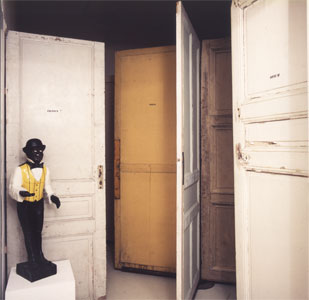
Born in 1955 in Somerville, New Jersey (US)
Lives and works in Mine Hill, New Jersey (US)

1997
Doors, metal structures
Dimensions variables
Year of Purchase: 1998
In the early 1990s, Willie Cole emerged on the American art scene with his assemblages of discarded items (shoes, irons, hair-dryers etc.) that he diverts from their initial purpose, turning them into fetishes, masks and engravings recalling African art. African symbols, signs, and divinities populate the work of this artist who, while claiming never to have set foot on the continent of Africa, devotes his efforts to rebuilding bridges between the two worlds, thereby restoring the cultural and identity heritages of the Afro-American community to which he belongs. A reading of this work cannot be reduced simply to cultural claims, as Cole exploits to the full the metaphorical potential of these used items and the singular stories they have to tell, creating a tension between the subjective experience and social and community pressures.
In the African Yoruba cosmology, Elegba, whom this work is named for, is the divinity of crossroads, and guardian of thresholds. He acts as a messenger between the divine and human worlds, governing individual choices and putting obstacles in the way of people who have a decision to make. As the principle of both good and evil, this god is also nicknamed the ‘Trickster’ and often depicted as a mischievous child.
The Elegba Principle is a maze of salvaged doors, at the entrance of which is the effigy of a black servant, identical to the statuettes that often used to be found at the entrance to American homes before the movement in defence of civil rights for black Americans appeared in the 1950s. On the used, ordinary-looking doors there are shreds of wallpaper, finger marks and graffiti. On each a word has been written, which may indicate a part of the body, a type of economy, a currency or a family situation, which the artist says he picks up as the opportunity arises from conversations or from his surroundings. Relations are then built up linking these keywords of a contemporary world modelled by its international relations and economic systems and the unique story of each of these doors with the person crossing the threshold.
Here the installation’s purpose is to move around; with no clear way out of this maze, the visitor just has to make a number of choices as to which way to go, and the unconnected phrases on the doors are not much help. Behind each door there are more labelled doors, and the visitor is forced to play a cruel, pointless game, a quest for nothing beyond the experience itself. This reveals the mechanics of choice, tinged with the absurdity of what we decide upon or against, and all the individual and collective determinism involved in this.
Corinne Charpentier